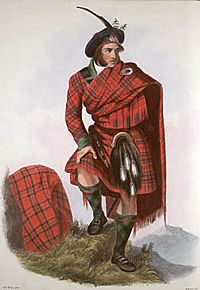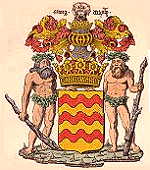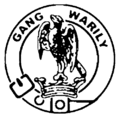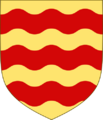Clan Drummond facts for kids
Quick facts for kids Clan Drummond |
|||
|---|---|---|---|
| An Druimeanaich | |||

Crest: On a crest coronet Or, a goshhawk wings displayed Proper, armed and belled Or, jessed Gules
|
|||
| Motto | Virtutem coronat honos (Honour crowns virtue) | ||
| Profile | |||
| Region | Highlands | ||
| District | Perthshire | ||
| Plant badge | Wild thyme; Holly | ||
| Pipe music | The Duke of Perth's March | ||
| Chief | |||
 |
|||
| James David Drummond | |||
| The 10th Earl of Perth de jure 19th Earl and 16th titular (Jacobite Peerage) Duke of Perth | |||
| Seat | Stobhall Castle | ||
| Historic seat | Drummond Castle | ||
|
|||
|
|||
Clan Drummond is a famous Highland Scottish clan. The family name is "Druimeanach" in modern Scottish Gaelic. The Drummonds have a long and interesting history in Scotland, known for their support of Scottish independence and their loyalty to the Stuart kings.
History of Clan Drummond
Where the Clan Began
Old Stories of the Drummonds
The name Drummond comes from the Scottish Gaelic word dromainn, meaning 'ridge' or 'high ground'. This refers to the area of Drymen, west of Stirling. An old story says the first Drummond nobleman was a Hungarian prince named George. He supposedly came to Scotland with an Anglo-Saxon prince, Edgar Ætheling, to escape William the Conqueror. They were welcomed by Malcolm III of Scotland, who married Edgar's sister, Margaret.
First Records of the Clan
The first known chief of Clan Drummond was Malcolm Beg. He was an important official in Lennox and married a daughter of the Earl of Lennox before 1260. Another early Drummond, Gilbert de Drumund, swore loyalty to Edward I of England in 1296. This was part of a document called the Ragman Rolls, where Scottish nobles had to promise loyalty to the English king.
Fighting for Scottish Freedom
During the Wars of Scottish Independence, the Drummond clan strongly supported Scotland's freedom. Malcolm Drummond fought bravely at the Battle of Bannockburn in 1314. He is famous for using caltrops, which were sharp metal spikes. These spikes were thrown on the ground to injure enemy horses and riders, helping the Scots win the battle. After this victory, Robert the Bruce, the Scottish king, gave the clan new lands in Perthshire.
The Drummond family became even more powerful in 1345. Chief John Drummond married a wealthy heiress, becoming John Drummond of Stobhall. John's sister, Margaret Drummond, married King David II of Scotland. Later, in 1367, John's daughter, Annabella Drummond, married John Stewart. He later became King Robert III of Scotland, making Annabella the Queen of Scotland and mother of King James I of Scotland.
Clan Life and Conflicts (1400s)
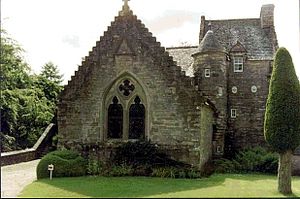
Sir Malcolm Drummond, a great-grandson of the Malcolm who fought at Bannockburn, received Stobhall Castle from his aunt, Queen Margaret. Sadly, Sir Malcolm was killed in 1403 by Highland raiders. These raiders were thought to be from the Clan Stewart of Appin.
John Drummond, a descendant of Sir John Drummond, became a very important figure in Scotland. He was a judge, a royal advisor, and the keeper of Stirling Castle. In 1487, he became the first Lord Drummond. He once spent a year in prison for attacking another important official. His daughter, Margaret, was said to have been close to King James IV of Scotland. She and her two sisters died suddenly after a meal.
In 1490, the Clan Drummond and Clan Campbell fought against the Clan Murray in the Battle of Knockmary. This was part of a long-running feud between the clans. David Drummond faced serious consequences after a conflict involving the Murrays.
Clan Life and Conflicts (1500s)
In 1589, Patrick, the 3rd Lord Drummond, made his relative, John Drummond of Drummond-Ernoch, the Royal Forester of Glenartney. John punished some members of the Clan MacGregor for poaching. In revenge, the MacGregors, with help from the Macdonalds, attacked and killed John Drummond. They then went to the home of John's sister, Margaret, at Ardvorlich Castle. Margaret, who was pregnant, was very scared. She ran into the woods and gave birth to her son, James Stewart. This son grew up to be a famous soldier and played a big part in having the MacGregor clan declared outlaws.
Clan Life and Civil War (1600s)
In 1610, James Drummond, the 1st Lord Madderty, built Innerpeffray Castle.
James Drummond, a descendant of John (Margaret's father), became the first Earl of Perth in 1605. His brother John took over as Earl after James died in 1611. The Drummond chiefs supported the Covenanters, a group who wanted to protect the Scottish church, against the Royalists (supporters of the King) in the Civil War. The 3rd Earl of Perth joined James Graham, 1st Marquis of Montrose, a Royalist leader, in 1645. He was captured at the Battle of Philiphaugh.
Around 1660, the grandson of James Drummond, 1st Lord Madderty, started a library at St Mary's chapel. Later, in 1751, Scotland's first public lending library was opened on the same site by Robert Hay Drummond.
The Clan Drummond also fought at the Battle of Killiecrankie in 1689, which was another important conflict in Scotland's history.
Jacobite Risings (1700s)
The 1715 Rising
When King James VII came to the throne in 1685, James Drummond, 4th Earl of Perth became a Catholic, as did his brother. Because of this, many Drummonds supported the Jacobite cause, which meant they wanted the House of Stuart (the old royal family) to return to the throne. Chief James Drummond, the 2nd Duke of Perth, joined the Jacobites in the Jacobite rising of 1715. He fought at the Battle of Sheriffmuir. After the battle, he had to flee to France, and his lands were taken away by the government.
The 1745 Rising
James Drummond, the 3rd Duke of Perth, was born in France but came back to Scotland in 1734. He lived at Drummond Castle. He was one of Charles Edward Stuart's (Bonnie Prince Charlie's) most trusted commanders. He was involved in the Siege of Carlisle during the Jacobite rising of 1745. Clan Drummond fought for the Jacobites at the battles of Falkirk (1746) and Culloden (1746). At Culloden, James Drummond, 3rd Duke of Perth, was shot. He later died from his injuries while escaping to France by boat. His brother, Lord John Drummond, also went to France. Their cousin, William Drummond, 4th Viscount Strathallan, was killed during the battle.
Because the Drummonds supported the Jacobites in 1715 and 1745, their property and titles were taken away twice. It wasn't until 1853 that the title of Earl of Perth and other titles were given back to George Drummond by an Act of Parliament.
Adam Drummond led the Drummond's Edinburgh Volunteers Regiment. This regiment fought for the British government at the Battle of Prestonpans in 1745, where Adam Drummond was captured.
The 20th Century
James Eric Drummond (1876–1951), the 16th Earl of Perth, was a very important person. He was the first secretary-general of the League of Nations, an organization created to promote world peace. He was also the British ambassador to Rome from 1933 to 1939 and advised the government during World War II.
His successor, John David Drummond, was able to buy back the family's historic home, Stobhall Castle.
Clan Castles

- Stobhall Castle, located seven miles north of Perth, is a 16th-century castle built around a courtyard. It has a special chapel from the 14th century with a painted ceiling from the 1630s. The Drummonds have held this castle since 1360. It was their main home until they moved to Drummond Castle in the 15th century. Today, Stobhall Castle is once again the main seat of the Clan Drummond chiefs.
- Drummond Castle, about a mile southwest of Crieff, in Perthshire, stands on a rocky hill. It dates back to the 15th century and includes a five-story tower. The castle was started by John Drummond, 1st Lord Drummond. In the 1650s, the castle was badly damaged by Oliver Cromwell's forces. This happened because James Drummond, the 3rd Earl of Perth, had supported James Graham, 1st Marquess of Montrose. The castle was also damaged by government troops during the Jacobite rising of 1715. Although the Drummonds lost their titles for supporting the Jacobites in 1745, the Earldom of Perth was restored in 1822. The Drummond Earls of Perth now live at Stobhall Castle.
- Newton Castle, northwest of Blairgowrie in Perthshire, is a 16th-century castle built on an older site. It was held by the Drummonds, who had feuds with the Blairs of Ardblair. The castle was attacked in 1644 and burned in 1650. However, people say the defenders survived in the castle's underground rooms while it burned. George Drummond, who was the Lord Provost of Edinburgh, came from the Drummond of Newton family. He was responsible for building the first part of New Town, Edinburgh.
- Balmoral Castle was owned by the Drummonds in 1390. It later passed to other families. In 1852, Prince Albert, Queen Victoria's husband, bought it.
- Megginch Castle was the home of Cherry Drummond, 16th Baroness Strange.
Clan Chief
The current chief of Clan Drummond is James David Drummond, 10th Earl of Perth. He holds several titles, including Lord Drummond and Lord Maderty. He is also the Hereditary Steward of Strathearn. His heir is Hon. Robert Eric Drummond.
Images for kids


